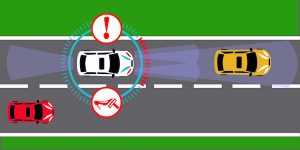Most vehicles sold today come with lane departure warning systems that alert drivers when their car is about to veer out of the lane and warns them to get back into the lane. That is the basic idea, but there are several versions of lane departure vision systems available now; including ones that react and steer away from the lane edge and can even proactively keep the car centered.
Each form of lane departure warning system employs a low-cost camera mounted in the windshield located near the rear-view mirror continuously watching the striped and solid lane markings of the road ahead. This lane departure warning system is part of the circle of safety, the three most common and useful driver assists: protecting you to the front (adaptive cruise control along with forward collision warning), side (lane departure warning), and rear side (blind spot detection).
There are three major forms of lane departure warning:
Lane keep assist: This helps the vehicle once it has drifted too far. The car then steers back away from the lane marking. The driver must then re-center the car in the lane. It is also called lane keeping system, lane assist, side assist (Audi), lane departure alert with steering assist (Toyota), or lane departure prevention (LDP is sometimes applied also to lane centering assist).
Lane departure warning: This is the original system. It is a warning only. When drivers let their car drift near, onto, or over the lane marking, the car will alert them. They then have to take corrective action by steering the car back to the middle of the lane. It doesn’t work if the road has no lane markings. It may not work, or not as well, where lane markings are faded. Lane marking dots are sometimes harder to track, especially if their coloring has faded. If it’s raining or snowing, the camera may have trouble, too. By design, the lane departure warning system doesn’t alert the driver if the turn signal is on, or (some cars) if the brakes are applied.
Lane centering assist: This is the best and newest system, as long as the driver trusts the technology. It’s a fully proactive system. Lane centering assist always tries to keep the car centered in the current lane. It works as long as the car senses that there are hands at least lightly on the steering wheel, and as long as curves aren’t too sharp. If the vehicle is equipped with lane centering assist and adaptive cruise control, it has the beginnings of what some would refer to as self-driving. At the very least, the combination is enough to save drivers from inattentiveness as they speed along, taking 5-10 seconds to look at a music playlist, or scanning a full-screen text. “Lane centering assist” is not as well-established as the other two terms.
Lane departure warning systems provide a valuable safety benefit, and can help keep drivers and passengers safe from crashes such as:
- Striking a car in an adjoining lane, which could either involve “sideswiping” a vehicle traveling in the same direction or
- hitting a vehicle traveling in the opposite direction
- A rollover, which often occurs when a vehicle leaves the road
Our automotive lenses are used by many of the major players in the automotive industry. We offer a wide variety of precision lenses and lens assemblies that are highly compatible with lane departure warning systems.